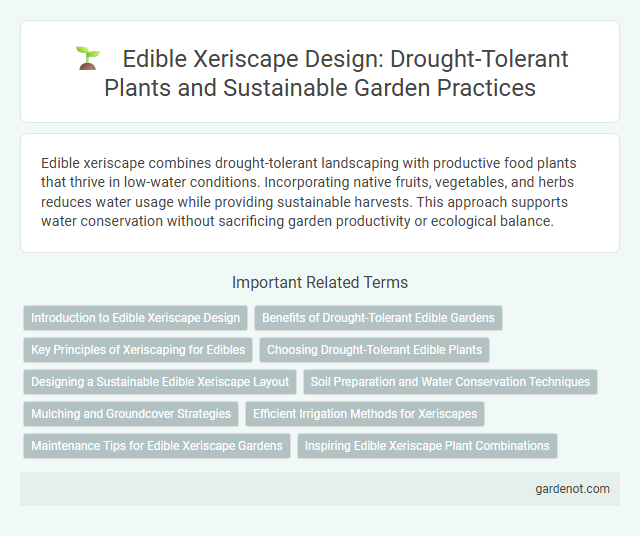Edible xeriscape combines drought-tolerant landscaping with productive food plants that thrive in low-water conditions. Incorporating native fruits, vegetables, and herbs reduces water usage while providing sustainable harvests. This approach supports water conservation without sacrificing garden productivity or ecological balance.
Introduction to Edible Xeriscape Design
Edible xeriscape design combines water-efficient landscaping principles with food-producing plants to create sustainable, drought-tolerant gardens. This approach utilizes native and adapted edible species such as drought-resistant herbs, fruits, and vegetables that thrive in low-water environments. Strategic plant placement and soil improvements enhance water retention, reducing irrigation needs while providing fresh, healthy produce.
Benefits of Drought-Tolerant Edible Gardens
Drought-tolerant edible gardens conserve water by utilizing native, drought-resistant plants like kale, quinoa, and beans that thrive in low-moisture conditions. These gardens enhance food security by providing reliable, low-maintenance crops during dry periods, reducing dependence on irrigation. Incorporating edible xeriscape designs promotes biodiversity, improves soil health, and lowers landscape maintenance costs.
Key Principles of Xeriscaping for Edibles
Xeriscaping for edibles emphasizes water-efficient gardening techniques such as selecting drought-tolerant fruit and vegetable varieties that thrive with minimal irrigation. Incorporating mulch and organic matter enhances soil moisture retention, reducing the need for frequent watering. Strategic plant placement maximizes sun exposure while minimizing water loss, ensuring sustainable and productive edible landscapes.
Choosing Drought-Tolerant Edible Plants
Selecting drought-tolerant edible plants for xeriscaping enhances water conservation while providing sustainable food sources. Candidates such as rosemary, thyme, nopales (prickly pear cactus pads), and amaranth thrive in arid conditions with minimal irrigation. Prioritizing native and adapted species ensures resilience, reduced maintenance, and maximized yield in a xeriscape garden.
Designing a Sustainable Edible Xeriscape Layout
Designing a sustainable edible xeriscape layout involves selecting drought-tolerant, nutrient-rich plants such as native herbs, fruit-bearing shrubs, and perennial vegetables that thrive in low-water conditions. Incorporating efficient irrigation methods like drip systems and mulching helps retain soil moisture and reduce water waste while maintaining plant health. Strategic zoning of edible plants based on sun exposure, soil type, and water needs maximizes productivity and sustainability in xeriscape gardens.
Soil Preparation and Water Conservation Techniques
Edible xeriscape garden success relies on well-prepared, nutrient-rich soil with proper aeration to support drought-tolerant crops such as herbs, fruit trees, and vegetables. Implementing mulching techniques like organic bark or straw reduces soil evaporation, maintains moisture levels, and suppresses weeds. Employing efficient irrigation systems such as drip irrigation ensures targeted water delivery, maximizing water conservation while promoting healthy plant growth in arid landscapes.
Mulching and Groundcover Strategies
Effective mulching in edible xeriscape conserves moisture by reducing evaporation and suppressing weeds, using organic materials like straw, wood chips, or shredded leaves that enrich soil nutrients. Groundcover plants such as creeping thyme, clover, or low-growing succulents provide natural weed barriers while improving soil structure and retaining moisture. Integrating these strategies optimizes water efficiency and promotes healthy growth of drought-tolerant edible plants.
Efficient Irrigation Methods for Xeriscapes
Efficient irrigation methods for edible xeriscapes include drip irrigation and soaker hoses, which deliver water directly to plant roots, minimizing evaporation and runoff. Soil moisture sensors and timers optimize watering schedules by monitoring actual moisture levels and reducing water waste. Mulching around edible plants further conserves moisture, enhances soil health, and supports water-efficient gardening in xeriscaped environments.
Maintenance Tips for Edible Xeriscape Gardens
Edible xeriscape gardens thrive with minimal water use by incorporating drought-tolerant plants like succulents, herbs, and native vegetables. Regularly mulching helps retain soil moisture and suppress weeds, reducing maintenance efforts. Pruning and harvesting at appropriate times promote healthy growth and increase yield in these sustainable, water-efficient gardens.
Inspiring Edible Xeriscape Plant Combinations
Edible xeriscape gardens thrive by integrating drought-tolerant fruits like pomegranates, figs, and olives with nutrient-rich herbs such as rosemary, thyme, and oregano. Combining these plants in layered designs maximizes space while enhancing soil health and water conservation through natural mulch and shade. This synergy not only produces abundant harvests but also creates resilient landscapes suited for arid environments.
Edible xeriscape Infographic

 gardenot.com
gardenot.com